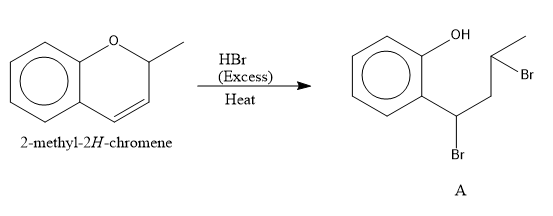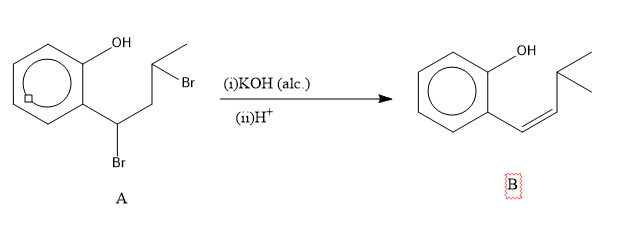
Consider the below reaction where 6.1 g of benzoic acid is used to get 7.8 g of m-bromobenzoic acid.

The percentage yield of the product is ______
(Round off to the nearest integer)
(Given: Atomic mass: C:12.0 u, H:1.0 u, O:16 u, Br: 80 u)
Answer
220.8k+ views
Hint: Percentage yield describes the ratio of the percentage of actual yield to the yield that is calculated theoretically. If the values of theoretical and actual yield are the same, then we get a percent yield of 100%.
Formula used:
The formula to find out percentage yield is,
% yield\[{\rm{ = }}\dfrac{{{\rm{Actual}}\,{\rm{weight}}}}{{{\rm{Theoretical}}\,{\rm{weight}}}}{\rm{ \times 100}}\]
Complete Step by Step Solution:
The reaction of ketone with HBr in excess results in the breaking of the bond. The reaction is as follows:

Image: reaction of ketone with HBr
As the HBr is in excess, so, the bromination at the o and p position takes place.
The next step is the reaction of A with alcoholic potassium hydroxide in presence of acid. The reaction of an alkyl halide in alcoholic potassium hydroxide results in the removal of halogen acid to form an alkene.
So, the reaction is,

Image: reaction of A with alcoholic potassium hydroxide in presence of acid
The next step is the reaction of B with Ozone in the presence of acid.

Image: reaction of B with Ozone in presence of acid
This is an ozonolysis reaction. Ozonolysis is a reaction in organic chemistry where the breaking of double or triple bonds of alkynes, alkenes or azo compounds takes place in reaction with ozone. Alkynes and alkenes form organic compounds where the replacement of multiple carbon-carbon bonds takes place by a carbonyl group whereas azo compounds give nitrosamines.
Hence, the product C is in option C.
Note: The higher value of percent yield indicates that there is contamination of the product by excess reactant, water or another substance. A lower value of percent yield signifies that there is mismeasurement of the reactant or there is spilling of a portion of the product.
Formula used:
The formula to find out percentage yield is,
% yield\[{\rm{ = }}\dfrac{{{\rm{Actual}}\,{\rm{weight}}}}{{{\rm{Theoretical}}\,{\rm{weight}}}}{\rm{ \times 100}}\]
Complete Step by Step Solution:
The reaction of ketone with HBr in excess results in the breaking of the bond. The reaction is as follows:

Image: reaction of ketone with HBr
As the HBr is in excess, so, the bromination at the o and p position takes place.
The next step is the reaction of A with alcoholic potassium hydroxide in presence of acid. The reaction of an alkyl halide in alcoholic potassium hydroxide results in the removal of halogen acid to form an alkene.
So, the reaction is,

Image: reaction of A with alcoholic potassium hydroxide in presence of acid
The next step is the reaction of B with Ozone in the presence of acid.

Image: reaction of B with Ozone in presence of acid
This is an ozonolysis reaction. Ozonolysis is a reaction in organic chemistry where the breaking of double or triple bonds of alkynes, alkenes or azo compounds takes place in reaction with ozone. Alkynes and alkenes form organic compounds where the replacement of multiple carbon-carbon bonds takes place by a carbonyl group whereas azo compounds give nitrosamines.
Hence, the product C is in option C.
Note: The higher value of percent yield indicates that there is contamination of the product by excess reactant, water or another substance. A lower value of percent yield signifies that there is mismeasurement of the reactant or there is spilling of a portion of the product.
Recently Updated Pages
The hybridization and shape of NH2 ion are a sp2 and class 11 chemistry JEE_Main

What is the pH of 001 M solution of HCl a 1 b 10 c class 11 chemistry JEE_Main

Aromatization of nhexane gives A Benzene B Toluene class 11 chemistry JEE_Main

Show how you will synthesise i 1Phenylethanol from class 11 chemistry JEE_Main

The enolic form of acetone contains a 10sigma bonds class 11 chemistry JEE_Main

Which of the following Compounds does not exhibit tautomerism class 11 chemistry JEE_Main

Trending doubts
JEE Main 2026: Application Form Open, Exam Dates, Syllabus, Eligibility & Question Papers

Derivation of Equation of Trajectory Explained for Students

Hybridisation in Chemistry – Concept, Types & Applications

Understanding the Angle of Deviation in a Prism

How to Convert a Galvanometer into an Ammeter or Voltmeter

Degree of Dissociation: Meaning, Formula, Calculation & Uses

Other Pages
NCERT Solutions For Class 11 Chemistry Chapter 7 Redox Reaction

JEE Advanced Marks vs Ranks 2025: Understanding Category-wise Qualifying Marks and Previous Year Cut-offs

Hydrocarbons Class 11 Chemistry Chapter 9 CBSE Notes - 2025-26

Thermodynamics Class 11 Chemistry Chapter 5 CBSE Notes - 2025-26

NCERT Solutions ForClass 11 Chemistry Chapter Chapter 5 Thermodynamics

Equilibrium Class 11 Chemistry Chapter 6 CBSE Notes - 2025-26




